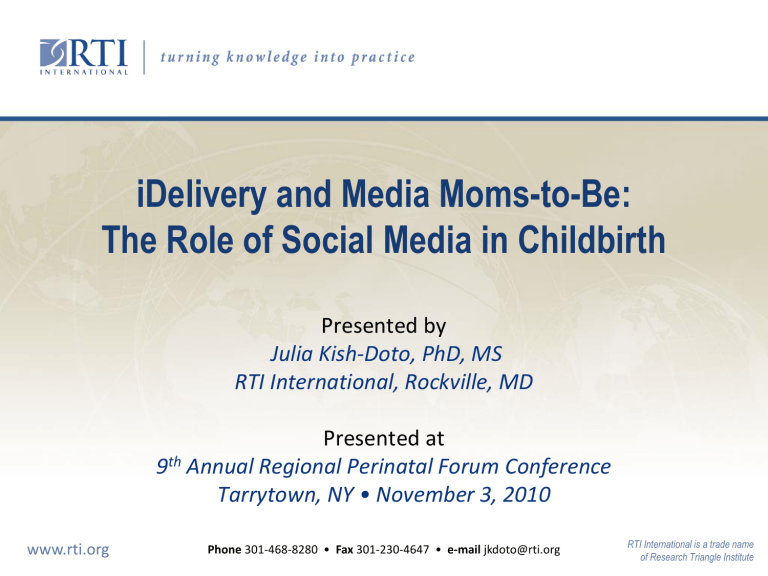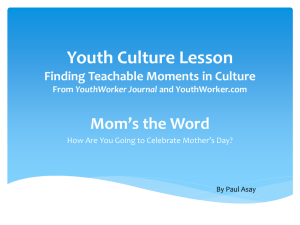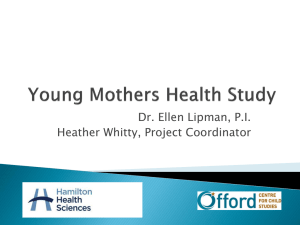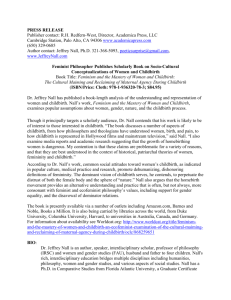Dr. Kish-Doto - Westchester Medical Center

iDelivery and Media Moms-to-Be:
The Role of Social Media in Childbirth
www.rti.org
Presented by
Julia Kish-Doto, PhD, MS
RTI International, Rockville, MD
9 th
Presented at
Annual Regional Perinatal Forum Conference
Tarrytown, NY • November 3, 2010
Phone 301-468-8280 • Fax 301-230-4647 • e-mail jkdoto@rti.org
RTI International is a trade name of Research Triangle Institute
2
Objectives
1.
Identify social media sources women use for health information
2.
Describe the role of social media and marketing in women’s health decision making
3.
Provide examples of how to use social marketing to communicate with and educate patients
3
Social Media and Network Examples
Blogspot
Flickr
YouTube
Wikipedia
Foursquare
Women’s Use of Social Media—Overall
4
The Oxygen Media Insights Group studied 1,600 women aged 18 to 34 (RBR, 2010):
34% say checking Facebook is the first thing they do in the morning
57% admit to talking to people online more than face to face
48% find out about news through Facebook more often than from traditional news outlets
73% say Facebook is “me time”
5
Moms in Particular
Control large segment of social market
“Power moms”– women between the ages of 25 and 54 who have at least one child under the age of 18 in the home – represent 19% of the total online population
(Nielsen Online, 2009)
Can be segmented by their “social” habits
6
Profile of Social Moms
(i.e., moms using social media)
Measured by “influence”
How often social moms post or comment on social networks
BabyCenter.com 2010 report
18% of moms who use social media account for
78% of the influence
7
Use of Social Media during Labor
Growing incidence of the following activities during labor:
Tweeting
Texting
Talking on a cell phone
Recording and posting in real time via webcams
8
Why?
To feel less alone
As a distraction
Because they can!
9
Possible Implications
Benefits
Expose future moms to positive birth experience
Increase knowledge of childbirth process
Drawbacks
Provider concerns about litigation
Instilling fear in moms-to-be
Questions about baby’s privacy rights
Boundaries of social etiquette
10
You Said It
“Facebook friends: My doctor is sewing up my episiotomy now. Thank God I can’t feel a thing!”
“OMG! I can’t handle another contraction! Where’s my epidural?! Somebody get me some DRUGS!”
(sent via iPhone)
» From Glynn, pregnancy360.com, 2010
11
The Problem
Data on the impact of women’s preferences on delivery mode and their decision-making processes for delivery are limited
A woman’s planned delivery preferences may not be the most predominant factor in the actual delivery
12
Influencing Factors
Other external factors beyond a woman’s physical state:
Health care providers
Insurance companies
Hospital protocols
Childbirth educators
Family, friends
Media
13
Behavior Change
Commercial marketers spend significant amounts of money examining the behaviors of their audience...
…and getting people to change them.
14
Related Example
Umbilical cord banking
Original idea in 1988 from not-for-profit
Today, companies have generated a “need” for the service
(Prue & Daniel, 2006)
15
There’s an App for That!
16
Moms-to-Be Information Seeking
Moms often turn to the Internet for health information before any other media source
Motherhood is the number one trigger for social media use
17
The Good News
Despite openness to social networking for health information, people typically connect with known acquaintances
(Uhrig, Bann, Williams, &
Evans, 2010)
18
The Challenge
Difficult for health care to compete
Motivational interviewing
Defined as changing what patients want to change
What if they don’t want to change?
Is the communicating audience/society better off?
19
Potential Solutions
Piggyback on existing market research
Use the same media channels
Initiate discussions
Upstream versus downstream approach
Work with insurance companies, policy makers, hospitals
20
Exposure and Awareness
Women are not typically exposed to normal, uncomplicated vaginal births
Media, provider’s offices, family, friends
Women may be unaware of childbirth education philosophies and practices supporting lowintervention vaginal births
21
Is It Tweet-Worthy?
Women rely heavily on social networks for health information, including childbirth knowledge (CDC, 2009)
Societal fascination with birth
Unexpected
Unplanned
Complicated deliveries
22
Current Social Marketing Programs
Text4Baby
www.childcount.org
Preconception health programs
READY-Girl
Patient-Provider Communication
23
How can providers use this information to reduce unnecessary or elective Cesarean sections?
24
Market to Your Audience
Questions to consider:
What is your office protocol to discuss preconception care with patients?
How is information delivered to/received from pregnant patients?
What questions are included in your electronic health records (EHR) system?
25
Recommendations
“Bundle” your messages
In discussions
On your office Web site
Foster a social network of communication about childbirth
Provide a list of links and sites to local childbirth resources
26
Recommendations (cont’d)
Ask questions about childbirth preference early and often
Dispel myths surrounding the process of childbirth
Educate women about the types, availability, and effectiveness of nonpharmacological coping techniques
27
References
The BabyCenter® 2010 Mom Social Influencer Report reveals five unique segments of social moms [News Release]. http://www.babycenter.com/100_-the-babycenter-174-2010-mom-social-influencer-report-reveal_10332899.bc
Accessed
October 25, 2010.
Centers for Disease Control and Prevention, Marketing and Communication Strategy Branch. Audience Insights: Communicating to moms (with kids at home). http://www.cdc.gov/healthmarketing/pdf/AudienceInsight_moms.pdf
Accessed October 25, 2010.
Glynn, A. The TMI of childbirth: From Tweeting intimate details of labor to posting full-frontal footage of baby’s birth—is nothing too sacred for social networking? http://www.pregnancy360.com/the-big-day/tmi-childbirth Accessed October 25, 2010.
The Nielsen Company. Nielson Online. Where the moms are: shopping, blogging, networking and strategizing online. [2009 News
Release]. http://enus.nielsen.com/content/dam/nielsen/en_us/documents/pdf/Press%20Releases/2009/May/Where%20The%20Moms
%20Are%20Shoppi g,%20Blogging,%20Networking%20And%20Strategizing%20Online.pdf
Accessed October 25, 2010.
Prue CE, Daniel KL. Social marketing: planning before conceiving preconception care. Matern Child Health J. 2006;10(Suppl 1):79–84. http://www.springerlink.com/content/a3j554763469n035/ Accessed October 25, 2010.
Radio and Television Business (RBR) Report. The social media habits of women 18–34 [News Release]. http://www.rbr.com/medianews/research/25649.html
Accessed October 25, 2010BabyCenter.com.
Uhrig J, Bann C, Williams P, Evans WD. Social networking websites as a platform for disseminating social marketing interventions: an exploratory pilot study. Soc Mar Q. 2010;16(1):2–20. http://www.informaworld.com/smpp/content~db=all~content=a919454461~frm=titlelink Accessed October 25, 2010.
www.rti.org
For more information contact
Julia Kish-Doto jkdoto@rti.org
RTI International is a trade name of Research Triangle Institute









